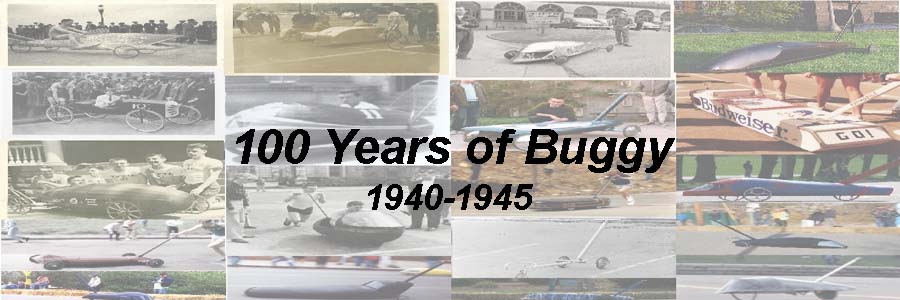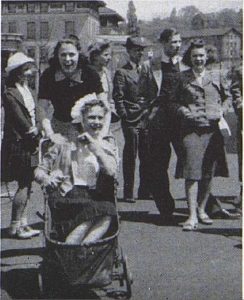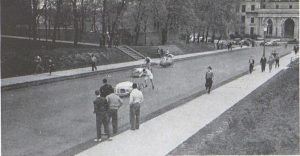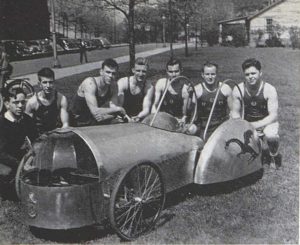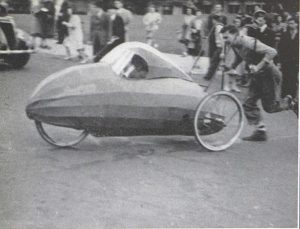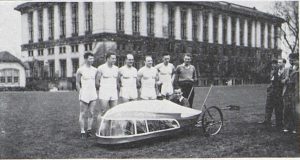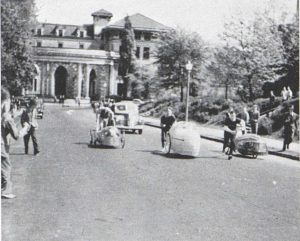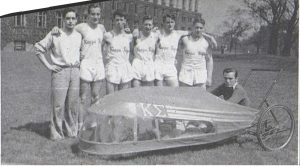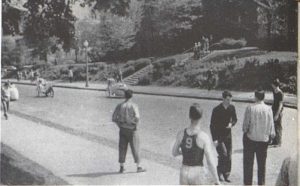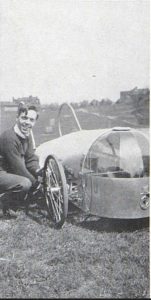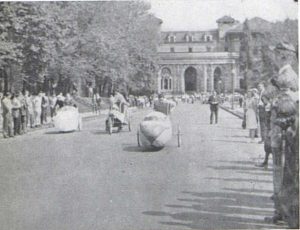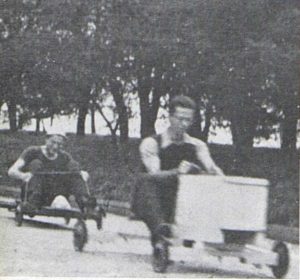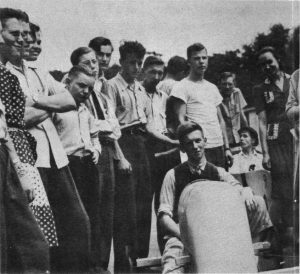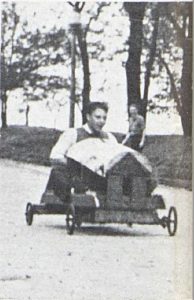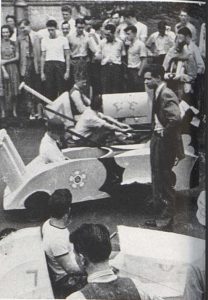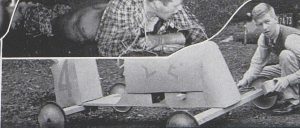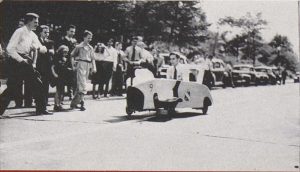Table of Contents: Intro & 1920; 1921-1923; 1924-1927; 1928-1932; 1933-1935; 1936-1939; 1940-1945; 1946-1949; 1950-1953; 1954-1956; 1957-1959; 1960-1963; 1964-1966; 1967-1969; 1970-1973; 1974-1976; 1977-1979; 1980-1983; 1984-1986; 1987-1989; 1990-1993; 1994-1996; 1997-1999; 2000-2003; 2004-2006; 2007-2009; 2010; 2011; 2012; 2013; 2014; 2015; 2016; 2017; 2018; 2019; Recap & 2020; 2021; 2022
This week, the 100 Years of Buggy History series battles the Axis Powers as we head into the World War II years. But before we get there, we learn a little about the culmination of KapSig’s reign of dominance, the problems with wheels, and the dangers of cars on the buggy course. Plus, we’ve got plenty of information about Fall Carnival in 1942, and the unofficial Buggy substitute, the Jalopy Race.
1940
Raceday: Prelims on Friday, May 10 at 10:30am; Finals on Saturday, May 11 at 2:30pm
Sweepstakes Committee: Walter C. “Bud” Wilson, Jr. (Chair)
Race Results: (1) KapSig (2:53); (2) Beta; (3) DU
Design Comp: (1) Beta
Weather: Sunny on Friday, Windy and Cool on Saturday; High of 67/58, Low of 42/44
We finally have copies of The Tartan from the archives again! Which means plenty of information, including KapSig’s 5th straight victory, some team troubles, and…a sorority race?
- Small Field. Either KapSig’s dominance or the remnants of the Great Depression must have scared teams away, because only 9 buggies were scheduled to enter, and only 7 ended up actually making it to the course for Raceday (the 5/10/1940 Tartan quoted Sweepstakes Chair Bud Wilson as saying that “more fraternities have entered [buggies] in the 1940 Carnival than ever before in the history of our institution”, though we know that’s false, as 18 teams entered as recently as 1933). The 7 competitors were: Beta, DTD, DU, KapSig, PiKA, SAE, and Theta Xi; ATO and PhiKap didn’t quite make it to Raceday.
- Meet The Teams. Here’s what we know about the teams (other than PiKA) from 1940 (in most cases, we have a person’s last name only):
- KapSig – KapSig returned their dominant buggy to the race, driven by Joe Thomas, and their push team consistent of Howarth, Ingalls, Gumbert, and Stauffer, with Big John Lloyd, known as “El Blindo” (I assume because he wore glasses), leading the way on Hill 1 (see photo below).
- DTD – DTD brought back their Buggy from 1939, and their push team included Pratt, Shepherd, and Steward.
- SAE – SAE built a new buggy for 1940, which had the center of gravity moved forward and the structure lowered. The driver was Bob Mahaffey and the push team included Herb May, Maurice Dondt, George Matonis, and Larry Moorman.
- Beta – Originally, reports were that Beta would bring back the same buggy that they rolled in 1939, but it looks like they opted to build a new buggy, known as the “Beta Baby”, instead. The push team included Ted Fisher, Joe Betz, and Boob Dominy (see photo below).
- Theta Xi – Theta Xi rolled their buggy known as the “Little Blue Comet”, which was shaped to look like a small blimp. Their push team included Mille, Anthony, and “Big Red” Sturgeon (the Varsity Track co-captain), and the buggy was driven by Charly Mundo.
- DU – DU kept everything under wraps until Raceday, making its buggy design a secret in 1940. Their push team included Jordano, Jones, Anderson, and Shearer, and the buggy was driven by Harold Cole (see photo below).
- ATO – ATO made some changes to the body design of their buggy from 1939. Their push team was expected to consist of Rader, Bevan, MacLaughlin and McMullen, and their buggy was supposed to be driven by Armand Cenci, though they didn’t end up racing.
- PhiKap – PhiKap was trying to return to buggy after some period of time off, and they were expected to roll out a new 3-wheeler that was driven by Tumpane. The pushers included Dobrus, Pruger, Laboon, and Haupt.
- DU’s Mishap. All 9 teams had reportedly been practicing at 6am every morning leading up to Raceday. On Friday, May 3, DU was one of the teams practicing. On the freeroll, driver Harold Cole got distracted and “forgot” about the Chute turn, resulting in a crash that left him with many scrapes and bruises. The buggy didn’t seem to suffer major damage though, as it returned for Raceday.
- PhiKap is in Wheel Trouble. PhiKap was ready to roll, except for one small issue…their wheels never arrived. So they were forced to scratch. Apparently they tried to order them for delivery? Pro tip to all the buggy teams out there – Make sure you get your wheels well before the day of the race.
- Women’s Racing…Kinda. The Tartan had been hyping up the existence of a Women’s Buggy race taking place on Saturday at 2pm, just prior to the Men’s Finals. When we started researching for this article, we were excited at the prospect of their being a Women’s exhibition 40 years prior to the known beginning of Women’s races. But alas, the Women’s race ended up being a baby buggy race: Each sorority placed a member, wearing a bonnet and equipped with a bottle and a rattle, inside of a baby stroller and put together 3-woman push teams. The race began essentially at the Buggy Finish Line and went the opposite direction down Frew Street. Officially, the race started outside of the “Beanery”, which per CMU’s University Archivist Julia Corrin was located where Hunt Library currently stands, with the first pusher transitioning to the 2nd at the end of Baker/Porter where the baby buggy would then turn right onto campus. The 2nd pusher then transitioned to the 3rd at CFA, and the 3rd would take the “buggy” to the finish line outside of Maggie Mo (where Sweepstakes would be set to begin). The sorority race was ultimately won by Gamma Phi Sigma. See photo right for a picture of what the “baby buggy” looked like.
- Prelim Results. The first heat pitted Beta (Lane 1), SAE (2), and Theta Xi (3) against each other, and Beta dominated the race, taking the lead from the jump and staying in front the entire way, finishing in 3:02. The second heat had KapSig (Lane 1), DU (2), DTD (3) and PiKA (4) competing. On their way up Hill 2, PiKA had a catastrophic wheel failure, as one of their wheel rims collapsed and entangled with the steering gear, causing the buggy to crash into the curb. They were ultimately allowed to run in a “trial” race on Saturday prior to the finals, and finished in a 3:14. As for the others, KapSig held only a narrow lead of approximately a half-length going into the freeroll, but their superior construction allowed them to pull away in the freeroll. DU and DTD were locked in a tight battle for 2nd, but ultimately DU prevailed.
- Finals. It was KapSig, Beta, and DU in the finals, but the race was never close. KapSig’s Hill 1 pusher, Big John “El Blindo” Lloyd gave KapSig a 1 second lead after Hill 1, and that was all she wrote. KapSig went on to win in a time of 2:53.
- Beta Baby Takes Design. Beta opted to build a new buggy in 1940, which was designed by Bill Mercier. And while that buggy was only able to elevate Beta to 2nd place in the race, it was designed well enough to win the Design Competition.
- More 1940 Photos:
1941
Raceday: Prelims on Friday, May 2 at 10:00am; Finals on Saturday, May 3 at 10:00am
Sweepstakes Committee: Jim McGarvey; Wes Dorsheimer
Race Results: (1) KapSig (2:55); Beta and DTD were 2nd and 3rd
Design Comp: (1) PiKA
Weather: Sunny; High of 70/66, Low of 48/39
1941 saw KapSig stretch it’s winning streak to a then-record 6 straight years, a rash of flat tires, and a vehicle issue that you probably wouldn’t see in today’s race.
- Early Morning Practices Begin. We don’t know exactly when off-campus practices gave way to early morning practice on the course itself, but by 1941, teams were limited in their practices to 5am-7am on the course. Teams began practicing some time in April.
- Rundown of Buggies. Originally, it was expected that 10 teams would compete, but SigNu ultimately dropped out SAE appears to have dropped out as well. For the 8 other orgs, here’s a breakdown of their buggies (2 new, 6 returning):
- PhiKap – PhiKap built a new buggy for 1941 after failing to get their wheels in time for the 1940 race. This new buggy was a 3-wheeler, with a steel frame and colored plastic coating.
- Theta Xi – Theta Xi also built a new buggy in 1941, though it was designed to be very similar to their previous buggy. The main difference was the addition of a covering, to make it more aerodynamic.
- KapSig – KapSig brought out their 5-time champion, making just their standard change to the silk covering design.
- Beta – Beta returned their new build from 1940, but removed some of the aluminum to make the buggy lighter.
- DTD – DTD’s buggy consisted of a hollow welded steel frame.
- DU – DU’s 3-wheeler, which was designed by Howard Cole, had a higher center of gravity than other buggies.
- ATO – ATO returned their (rarely seen on the course by 1941) 4-wheeler, with a wooden framework and no covering; a real old-school model.
- PiKA – PiKA brought back the same buggy from 1940, but made some adjustments to prevent the buggy from crumpling as it did when it crashed in 1940 on its way up the front hills.
- Car Crash. The race was run in 2 heats, with 4 buggies expected to move on to the Finals (though it’s unclear if it was supposed to be the 4 fastest times, or the top 2 from each heat; ultimately, only 3 advanced). Heat 2 was pretty uneventful, as the only drama came when PhiKap’s 3-wheeler enter the freeroll first, but KapSig was able to pass it in the freeroll and cruise to a Prelim time of 2:53 (Beta finished 2nd). In Heat 1, DU’s 3-wheeler got up the front hills and went into the freeroll first, followed by DTD. DU’s lead widened during the freeroll…until a car appeared on the course. DU swerved to avoid the car but ended up hitting and going over the curb, breaking one of their wheels. Apparently the wheel damage wasn’t an unexpected occurrence though; on the two previous days, DU broke the same wheel in the same location during practice rolls, but they were able to repair it both times. Unfortunately, you only get one chance on Raceday…
- Flat Tires. …Or do you? PiKA’s changes to fix the flaws of 1940 may have helped with the structure of the buggy, but it didn’t help with the tires, as PiKA was forced to scratch from its Heat on Friday due to a flat time that couldn’t be repaired in time. Not to be outdone, ATO said “if your 3-wheeler can have 1 flat tire, our 4-wheeler can have 2!”, and they were also forced to scratch. To be fair to the competitors, the judges decided to let both PiKA and ATO “reroll” on Saturday before the Finals. Of course, neither PiKA nor ATO would have been competitive for the trophy because no push team would be able to push again at full speed in the Finals (which was immediately after the reroll). But it turns out, it didn’t matter anyway. During the reroll, both ATO and PiKA fell victim to “Crash Hill”; ATO went into the freeroll first but crashed, and PiKA crashed when they swerved to avoid the spilled ATO buggy.
- KapSig’s Record 6th. The three teams advancing to the finals were KapSig, Beta, and DTD. KapSig was the heavy favorite to take home their 6th straight trophy, but they began in Lane 3, and as a result they had to circle around the traffic signal at the top of Hill 2, making the course 10 yards longer for them. This caused KapSig to be 3rd going into the freeroll. But that was as much drama as the race could produce, as KapSig easily passed Beta and DTD to win their then-record 6th straight Raceday in 2:55. The winning team was made up of John Lindberg (Hill 1), James Stauffer (Hill 2), Bud Burns (Hill 3), Eddie Chipman (Hill 4), and Frank Pritchard (Hill 5) (a completely new push team from 1940), along with returning driver Joe Thomas.
- More 1941 Photos:
1942
1942 is an interesting year. Officially, there was no Sweepstakes, after Spring Carnival was reduced and Buggy cancelled due to the declaration of World War II. But we’ve still got an interesting story to tell from the year, including the Sweepstakes replacement, the Jalopy Race, during the Fall Carnival. All information below about the race itself is referring to that Jalopy race, though you will learn why this is not officially part of the Sweepstakes record books.
- Spring Carnival Reduced; Buggy Cancelled. From the Tartan editions in the Fall of 1941, everything was on track to have Spring Carnival in May again. In fact, a request was made (and denied) to make the 1942 Spring Carnival into a four day event, and they had already set Spring Carnival 1943 to occur on May 6-8. However, after the US declared war on Japan and Germany in December 1941, Spring Carnival for 1942 was significantly reduced, and one of the effects was that Buggy was cancelled (as a note, The Tartan may have also been reduced…Spring 1942 is missing from the digital archives, so we don’t exactly know when the decision was made).
- Fall Carnival Debuts. In years past, Spring Carnival had been so successful that in Fall 1941, the students decided to add a Fall Carnival! The first one took place in 1941 as a smaller version of Spring Carnival, though there were no buggy races. However, due to the reduction of Spring Carnival in 1942 and cancellation in 1943, the 1942 Fall Carnival (the second and final Fall Carnival) added a Sweepstakes-style race to the calendar. The 1942 Fall Carnival took place on September 18-19, 1942, and the Sweepstakes event was known as the “Jalopy Race”.
- Independents Allowed. For 22 years, Buggy had typically been open only to fraternities (with occasional exceptions for other greek organizations and/or the men’s dorms). But with the new Jalopy Race, the rules permitted any campus organization, club or department to compete, and each organization could enter “one or more” jalopies. If there were 5 or more fraternities and 5 or more independents, the Jalopy Race was going to be split into 2 divisions; however, we don’t believe that happened, and I’m not sure any independent organizations actually entered. The race was also scheduled to be run in heats, with starting positions drawn by chance.
- Jalopy Materials Limited. Because of the War, an additional rule was added – Jalopies were not permitted to contain any materials that “might instigate tension with the [War Production Board]”. Essentially, this meant that jalopies could contain no metal and the tires could not be rubber. The WPB rationed commodities such as gasoline, heating oil, metals, rubber, paper, and plastics, and in particular limited access to steel, aluminum, and rubber.
- Supporting The War. Jalopies were also required to show their patriotic side. Each Jalopy was required to have a license plate (5” x 10”) designed in any combination of red, white, and blue, and a 25 cent war stamp was required to be placed in the middle.
- Other Jalopy Race Rules. The rulebook for the Jalopy Race was longer than the Sweepstakes rulebook of the day, with 13 rules in all. Other rules included (1) a $1 entry fee per Jalopy; (2) the Jalopy must be no less than 2 feet and no more than 15 feet long; (3) the Jalopy must have at least 3 circular wheels with a diameter of no more than 16 inches, and pneumatic tires are prohibited; (4) no internal propulsion (gas, steam, oil, electricity, liquid air, etc.) is permitted; and (5) neither the driver nor his clothes were permitted to touch the ground at any time.
- Jalopy Course. The course wasn’t quite as long as the Buggy course. The Jalopy Race began on Frew Street by the “Beanery” (as previously noted, we’re not quite sure where exactly the Beanery is; my current guess is that it’s roughly the basement of Porter Hall). It then went to Tech Street and made a left turn, going down Hill 1 to the finish line at the bottom of the hill. The Tartan notes that “ample stopping distance will be allowed beyond the finish line.”
- Race Results. We don’t know too much about the race itself. But we know that KapSig continued their dominance in pushmobile sports. Ultimately, KapSig’s Jalopy, driven by Stu Lee, won the race, with SAE’s Jalopy, driven by Fred Kelsey, finishing 2nd. Other notables included PiKA’s Jalopy, which looked like a Jeep and made the ladies swoon but lacked speed, and the Men’s Dorms Jalopy, which involved them putting driver Stan Shiller (from Scobell House) on a board and building the vehicle around him (the article cites a “rumor” that he was fed through a straw until post time, and that he had been in there so long that when he was finally pried out, he had grown a beard and knitted four sweaters for the American soldiers in Ireland).
- 1942 Photos: Here are some photos from the Jalopy Race.
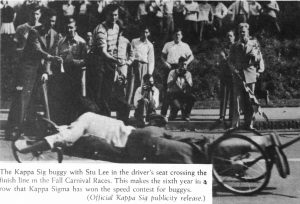
1943-1945
Spring Carnival, and with it Sweepstakes, was cancelled due to World War II. In fact, due to the number of male students who either enlisted or were drafted into the military (after the deferment for engineering students was cancelled), a significant number of fraternities suspended their operations until their brotherhoods returned home from the war. But once the war ended and students started returning to campus, school activities started picking up. And by 1946, Buggy would return with a complete overhaul of style. But more on that next week…

